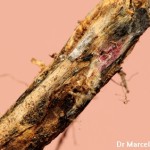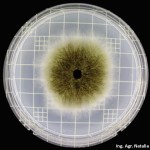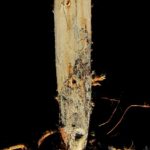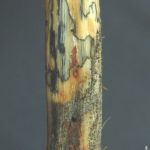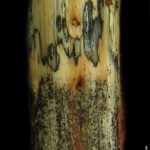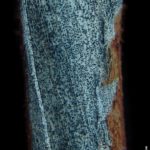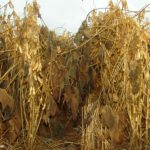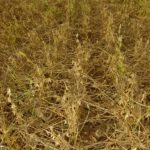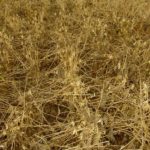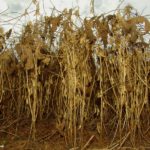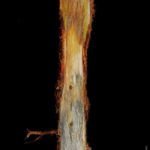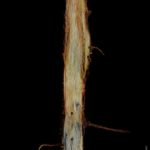.
Condición fitosanitaria: Presente
Grupo de cultivos: Oleaginosas
Especie hospedante: Soja (Glycine max)
Rango de hospedantes: no específico / amplio
Epidemiología: monocíclica, subaguda.
Etiología: Hongo. Necrotrófico
Agente causal: Macrophomina phaseolina (Tassi) Goidanish
Taxonomía: Eukaryota > Fungi > Dikarya > Ascomycota > Pezizomycotina > Dothideomycetes > Dothideomycetes incertae sedis > Botryosphaeriales > Botryosphaeriaceae > Macrophomina
.
.
Antecedentes
Macrophomina phaseolina es un hongo fitopatógeno que causa la podredumbre carbonosa de la base del tallo de la soja además de afectar a otros 500 hospedantes, como maíz, sorgo, girasol y producir daños de hasta el 80% del rendimiento. De todos los hongos que afectan las raíces de soja, M. phaseolina merece la mayor atención porque la enfermedad está incrementándose en forma sostenida, independientemente del manejo o rotación agrícola utilizada. Este escenario, sumado a lo complejo de su control, constituye una amenaza a la sustentabilidad agrícola.
.
Síntomas
La enfermedad puede aparecer en cualquier estado fenológico del cultivo y su aparición causa elevados porcentajes de plantas muertas en los lotes. En plántulas se observan lesiones irregulares en la base de los cotiledones, con decoloración castaña rojiza oscureciéndose posteriormente, las que se extienden por el tallo causando estrangulamiento y muerte. Se produce una pudrición marrón a marrón oscuro. En plantas adultas causa obstrucción del sistema vascular por la producción de microesclerocios de color negro o gris, que pueden observarse debajo de la corteza y en la médula, llevando al marchitamiento y muerte de las plantas. Los síntomas típicos en estas etapas son lesiones negras a grises en la base de los tallos, muchas veces con líneas oscuras en la médula (formadas por microesclerocios).
.
Patogénesis
Las enzimas más significativas secretadas por M. phaseolina son pectinasas, xilanasas, celulasas y proteasas (Tonukari, 2003). Las pectinasas rompen la pectina de la célula hospedante y usan carbono como fuente de patogénesis, mientras que la exo- y endopoligalacturonasa se producen en la patogénesis temprana y la colonización de los tejidos del hospedante (Murad y Azzaz, 2011). Las lipasas también son producidas por M. phaseolina y causan la hidrólisis de las grasas, mono y diglicéridos en ácidos grasos libres y glicerol (Kakde y Chavan, 2011). También produce ciertas toxinas, como la faseolinona y la botryodiplodin, que facilitan la infección (Ramezani, 2008; Bressano et al., 2010). Se ha informado que la producción de enzimas hidrolíticas desempeña un papel crucial en el desarrollo de la enfermedad (Kaur et al., 2012).
Estas toxinas causan necrosis en tejidos vegetales en varias plantas y principalmente debido a la lisis de la membrana. Mathur (1968) observó por primera vez que M. phaseolina produce sustancias fitotóxicas en cultivos que muestran síntomas de enfermedad similares a los de un patógeno.
.
Condiciones ambientales predisponentes para el establecimiento de la enfermedad y epidemilogía
Condiciones de sequía con altas temperaturas, imperantes en regiones con climas tropicales y subtropicales. La temperatura óptima para el desarrollo del hongo se ubica en el rango 28 a 35°C. La enfermedad se manifiesta generalmente en rodales, y el hongo persiste como microesclerocios en el rastrojo y en el suelo. El rastrojo infestado, la semilla infectada y los microesclerocios en general, constituyen la fuente de inóculo primario.
.
Epidemiología
Los microesclerocios infectan las raíces de las plantas bajo la influencia de exudados radicales, desde donde se propaga hacia el brote, en donde forma numerosas nuevos microesclerocios, en el tejido en descomposición. El patógeno se ve muy favorecido por factores predisponentes, como períodos cálidos y secos después de períodos de buenas condiciones de crecimiento. Los microesclerocios sobreviven en el suelo durante varios años.
.
Hospedantes Susceptibles
M. phaseolina es un hongo polífago con un amplio rango de hospedantes y de amplia difusión mundial, que es capaz de infectar más de 500 hospedantes, entre los que se encuentran:
* Ajo (Allium spp)
* Alfalfa (Medicago sativa)
* Algodón (Gossypium spp)
* Arveja (Pisum spp)
* Amaranthus (Amaranthu spp)
* Avena (Avena sativa)
* Begonia (Begonia spp)
* Berenjena (Solanum melongena)
* Cannabis (Cannabis spp)
* Caupí (Vigna sinensis)
* Cítricos (Citrus spp)
* Crisantemo (Chrysanthemum spp)
* Esparrago (Asparagus spp)
* Frutales de carozo (Prunus spp)
* Frutilla (Fragaria spp)
* Garbanzo (Cicer arietinum)
* Girasol (Helianthus annuus)
* Haba (Vicia spp)
* Lechuga (Lactuca spp)
* Lilium (Lilium spp)
* Lino (Linum usitatissimum)
* Loto (Lotus corniculatus)
* Maiz (Zea mays)
* Maní (Arachis hypogaea)
* Melilotus (Melilotus spp)
* Melón (Citrullus lanatus)
* Nabo (Brassica spp)
* Olivo (Olea europaea)
* Papa (Solanum tuberosum)
* Pepino (Cucumis spp)
* Pimiento (Capsicum annuum)
* Poroto (Phaseolus vulgaris)
* Pino (Pinus spp)
* Remolacha (Beta vulgaris)
* Roble (Quercus spp)
* Salvia (Salvia hispanica)
* Sésamo (Sesamum indicum)
* Soja (Glycine max)
* Sorgo (Sorghum bieolor)
* Tabaco (Nicotiana tabacum)
* Tomate (Solanum lycopersicum)
* Trébol (Trifolium spp)
* Vid (Vitis spp)
* Zapallo (Cucurbita spp)
.
Manejo de la enfermedad
El hongo posee varios hospedantes y sobrevive en el suelo en forma de microesclerocios. Los residuos de soja infestados también garantizan la supervivencia del patógeno y junto con el suelo constituyen las fuentes primaria de inoculo. Los microesclerocios sobreviven más de dos años en suelos secos, pero son de escasa viabilidad en suelos húmedos.
* La rotación con cultivos no susceptibles (2 a 3 años) es una de las prácticas recomendable. La rotación de cultivos puede ser un método aceptable para reducir la incidencia de la enfermedad en soja, aunque los otros cultivos de la rotación sean hospedantes de M. phaseolina (Francl et al., 1988).
* Eliminación de factores predisponentes, especialmente el mantenimiento del riego durante los períodos de clima cálido puede ser una opción efectiva.
* Las enmiendas del suelo ricas en Nitrógeno pueden suprimir parcialmente al patógeno.
* Uso de material de siembra libre de enfermedades.
Es de difícil manejo por las prácticas tradicionales de control, por eso actualmente se buscan nuevas estrategias. La supresividad de algunos suelos (presencia de microflora antagonista que compite con el hongo) parece ser una buena alternativa para su manejo.
También es clave evitar toda situación de estrés para el cultivo. Actualmente no existen fungicidas sistémicos que se movilicen hacia la raíz, para interactuar con los patógenos que allí establecen su infección, lo que limita su manejo, esto indica un crecimiento continuado de la importancia de M. phaseolina tanto en Argentina, como en Brasil (Reis et al., 2010; Carmona & Reis, 2012).
.
- Tallo de soja infectado con Macrophomina phaseolina. Autor: Dr. Marcelo Carmona
- Colonia de Macrophomina phaseolina creciendo en PDA. Autor: Ing. Natalia Pin Viso
- 01 Semillas de soja infectadas y colonizadas por Macrophomina phaseolina. Autor: Ing. Mg. Francisco Sautua
- 02 Semilla de soja infectada y colonizada por Macrophomina phaseolina. Autor: Ing. Mg. Francisco Sautua
- 03 Semilla de soja infectada y colonizada por Macrophomina phaseolina, corte transversal. Autor: Ing. Mg. Francisco Sautua
- 04 Microesclerocios de Macrophomina phaseolina, en semilla de soja infectada y colonizada, corte transversal. Autor: Ing. Mg. Francisco Sautua
- Microesclerocios de Macrophomina phaseolina en tallo de soja. Fuente: Photchana Trakunsukharati, Department of Agriculture, Thailand.
- Autor: Ing. Dirceu Gassen
- Autor: Ing. Dirceu Gassen
- Autor: Ing. Dirceu Gassen
- Autor: Ing. Dirceu Gassen
- Autor: Ing. Dirceu Gassen
- Autor: Ing. Dirceu Gassen
- Autor: Ing. Dirceu Gassen
- Autor: Ing. Dirceu Gassen
- Autor: Ing. Dirceu Gassen
- Autor: Ing. Dirceu Gassen
- Autor: Ing. Dirceu Gassen
- Autor: Ing. Dirceu Gassen
- Autor: Ing. Dirceu Gassen
- Autor: Ing. Dirceu Gassen
- Autor: Ing. Dirceu Gassen
- Autor: Ing. Dirceu Gassen
- Autor: Ing. Dirceu Gassen
- Autor: Ing. Dirceu Gassen
- Síntomas a campo de la pudrición carbonosa. Autor: Daren Muller, Iowa State University.
Videos
Charcoal Rot in the North Central Region: Identification in the Field
Charcoal Rot in the North Central Region: Life Cycle
Macrophomina phaseolina Isolation & CFU Quantification Protocol. Purdue Field Crop Pathology
Macrophomina (podridão de raízes) na soja – Canal Agro Paraguay
.
.
.
Bibliografía
Macrophomina phaseolina. Sistema Nacional Argentino de Vigilancia y Monitoreo de plagas
Abbas HK, Shier WT, Allen TW, et al. (2014) Phytotoxicity of the mycotoxin (±)-botryodiplodin (Bot) produced by Macrophomina phaseolina to soybean and duckweed in vitro. 2014 APS-CPS Joint Meeting, August 9-13, Minneapolis, Minnesota.
Abbas H, Bellaloui N, Accinelli C, et al. (2019) Toxin production in soybean (Glycine max L.) plants with charcoal rot disease and by Macrophomina phaseolina, the fungus that causes the disease. Toxins 11: 645. doi: 10.3390/toxins11110645
Abbas HK, Bellaloui N, Butler AM, , et al. (2020) Phytotoxic responses of soybean (Glycine max L.) to botryodiplodin, a toxin produced by the charcoal rot disease fungus, Macrophomina phaseolina. Toxins 12(1): 25. doi: 10.3390/toxins12010025
Aguaysol NC, Reznikov S, De Lisi V, et al. (2014) Sub-fases asexuales de Macrophomina phaseolina en el cultivo de poroto. Libro de resumenes del 3º Congreso Argentino de Fitopatologia. p. 172.
Aguaysol NC, Acosta ME, González V, et al. (2013) Avance Agroindustrial 34 (4). Diciembre de 2013. En: Patógenos detectados en semillas de garbanzo (Cicer arietinum) en Tucumán y áreas de influencia. Estación Experimental Obispo Colombres. pp. 28-30.
Aguaysol NC, González V, Fogliata GM, Ploper LD (2015) Patógenos detectados en semillas de poroto (Phaseolus vulgaris) procedentes de la provincia de Salta. En: XV Jornadas Fitosanitarias Argentinas. Santa Fe, octubre de 2015. Libro de resúmenes. pp. 20. ISBN/ISSN: 2451 – 8069.
Aguaysol N, Robles Terán L, Gonzalez V, et al. (2014) Detección temprana de Sclerotinia sclerotiorum en cultivos de chía (Salvia hispánica) en Tucumán durante la campaña 2014. Editor/es: Estación Experimental Obispo Colombres (EEAOC). Estación Experimental Obispo Colombres (EEAOC).
Aguirre CM, Ramallo AC, Salazar CM, et al. (2011) Obtención y caracterización de aislamientos de Macrophomina phaseolina de frutilla en Tucumán, Argentina. Libro de resúmenes del 2º Congreso Argentino de Fitopatología. 1. pp. 96. ISBN/ISSN: ISBN 978-987-544-389-1.
Aguirre CM, Ramallo AC, Salazar SM, et al. (2013) Evaluación de cultivares de frutilla (Fragaria ananassa Duch.) resistentes a Macrophomina phaseolina. XXXVI Congreso Argentino de Horticultura. pp. 303.
Alam S, Abbas HK, Sulyok M, et al. (2022) Pigment Produced by Glycine-Stimulated Macrophomina phaseolina Is a (−)-Botryodiplodin Reaction Product and the Basis for an In-Culture Assay for (−)-Botryodiplodin Production. Pathogens 11(3): 280. doi: 10.3390/pathogens11030280
Alcoba NJ, Bejarano N, Catacata JR (2005) Enfermedades de los cultivos de Jujuy y Salta – Diagnosticadas en el laboratorio de Fitopatología de la Facultad de Ciencias Agrarias de la UNJu. – 1ª Edición. Eds. Editorial de la Universidad Nacional de Jujuy. Ediunju. San Salvador de Jujuy. pp. 74. ISBN/ISSN: 950-721-191-8.
Alizadeh M, Khodadadi Manesh S, Fathi P, et al. (2025) Biology and Host Ranges of the Plant Pathogenic Fungus Macrophomina Phaseolina: a Comprehensive Review. Journal of Crop Health 77: 50. doi: 10.1007/s10343-024-01106-4
Almeida AMR, Amorim L, Bergamin Filho A, et al. (2003) Progress of soybean charcoal rot under tillage and no-tillage systems in Brazil. Fitopatologia Brasileira 28: 131-135. doi: 10.1590/S0100-41582003000200002
Almeida AMR, Abdelnoor RV, Arias CAA, et al. (2003) Genotypic diversity among brazilian isolates of Macrophomina phaseolina revealed by RAPD. Fitopatologia Brasileira 28(3): 279-285. doi: 10.1590/S0100-41582003000300009
Almeida AMR, Sosa-Gomez DR, Binneck E (2008) Effect of crop rotation on specialization and genetic diversity of Macrophomina phaseolina. Tropical Plant Pathology 33: 257-264. doi: 10.1590/S1982-56762008000400001
Almomani F, Alhawatema M, Hameed K (2013) Detection, identification and morphological characteristic of Macrophomina phaseolina: the charcoal rot disease pathogens isolated from infected plants in Northern Jordan. Archives of Phytopathology and Plant Protection 46(9): 1005-1014. doi: 10.1080/03235408.2012.756174
Alzugaray C, Carnevale NJ, Salinas AR, Pioli R (2007) Factores bióticos y abióticos que afectan la calidad de las semillas de Schinopsis balansae Engl. y Aspidosperma quebracho-blanco Schltdl. Revista Iberoamericana de Micología.
Azarmanesh N, Saini M, Bond J, Fakhoury AM (2011) Identifying Macrophomina phaseolina genes involved in phytotoxin phaseolinone production using cDNA-AFLP analysis. APS IPPC Joint Meeting, August 6-10, 2011, Honolulu, Hawaii.
Banaras S, Javaid A, Shoaib A, Ahmed E (2017) Antifungal activity of Cirsium arvense extracts against phytopathogenic fungus Macrophomina phaseolina. Planta Daninha 35. doi: 10.1590/s0100-83582017350100014
Bandara YMAY, Weerasooriya DK, Liu S, Little CR (2018) The Necrotrophic Fungus Macrophomina phaseolina Promotes Charcoal Rot Susceptibility in Grain Sorghum Through Induced Host Cell-Wall-Degrading Enzymes. Phytopathology 108(8): 948-956. doi: 10.1094/PHYTO-12-17-0404-R
Basandrai AK, Pandey AK, Somta P, Basandrai D (2021) Macrophomina phaseolina‐host interface: Insights into an emerging dry root rot pathogen of mungbean & urdbean, and its mitigation strategies. Plant Pathology. Accepted Author Manuscript. doi: 10.1111/ppa.13378
Bellaloui N, Mengistu A, Smith JR, et al. (2021) Effects of Charcoal Rot on Soybean Seed Composition in Soybean Genotypes That Differ in Charcoal Rot Resistance under Irrigated and Non-Irrigated Conditions. Plants. 10(9): 1801. doi: 10.3390/plants10091801
Bellaloui N, Mengistu A, Smith JR, et al. (2023) Soybean Seed Sugars: A Role in the Mechanism of Resistance to Charcoal Rot and Potential Use as Biomarkers in Selection. Plants 12(2): 392. doi: 10.3390/plants12020392
Benegas A, Cubilla-Ríos AA, Flores-Giubi ME, et al. (2022) Extracción de proteínas secretadas por el fitopatógeno Macrophomina phaseolina: Selección de un método eficiente que incluye estímulo con tejido de su hospedero. Scientia Agropecuaria 13(2): 185-192. doi: 10.17268/sci.agropecu.2022.017
Bhattacharya D, Dhar TK, Ali E (1992) An enzyme immunoassay of phaseolinone and its application in estimation of the amount of toxin in Macrophomina phaseolina-infected seeds. Appl. Environ. Microbiol. 58: 1970-1974. doi: 10.1128/aem.58.6.1970-1974.1992
Bhattacharya D, Dhar TK, Siddiqui KAI, Ali E (1994) Inhibition of seed germination by Macrophomina phaseolina is related to phaseolinone production. Journal of Applied Bacteriology 77: 129–133. doi: 10.1111/j.1365-2672.1994.tb03055.x
Bhutada S, Shinde M (2023) Chapter 17 – Biocontrol of charcoal rot by soil microorganisms. Macrophomina phaseolina Ecobiology, Pathology and Management. Pages 253-264. doi: 10.1016/B978-0-443-15443-0.00008-5
Bressano M, Giachero ML, Luna CM, Ducasse DA (2010) An in vitro method for examining infection of soybean roots by Macrophomina phaseolina. Physiological and Molecular Plant Pathology 74: 201–204. doi: 10.1016/j.pmpp.2009.12.003
Brown S, Shahrtash M, Stokes C, et al. (2023) Model-based community analyses identify fungal endophytes that may modulate symptom development of charcoal rot disease in soybean. PhytoFrontiers. doi: 10.1094/PHYTOFR-04-23-0052-SC
Carmona M, Reis EM (2012) Enfermedades en cultivos bajo siembra directa en Argentina y Brasil: pasado, presente y prospectivas de manejo. Revista soja en Siembra directa AAPRESID pp. 48-55, Octubre de 2012.
Castaldi S, Petrillo C, Donadio G, et al. (2021) Plant Growth Promotion Function of Bacillus sp. Strains Isolated from Salt-Pan Rhizosphere and Their Biocontrol Potential against Macrophomina phaseolina. International Journal of Molecular Sciences 22(7): 3324. doi: 10.3390/ijms22073324
Castaldi S, Masi M, Sautua F, et al. (2021) Pseudomonas fluorescens Showing Antifungal Activity against Macrophomina phaseolina, a Severe Pathogenic Fungus of Soybean, Produces Phenazine as the Main Active Metabolite. Biomolecules 11(11): 1728. doi: 10.3390/biom11111728
Chakraborty U, Purkayastha RP (1984) Role of rhizobitoxine in protecting soybean roots from Macrophomina phaseolina infection. Canadian Journal of Microbiology 30: 285-289. doi: 10.1139/m84-043
Chamorro M, Seijo TE, Noling JC, et al. (2016) Efficacy of fumigant treatments and inoculum placement on control of Macrophomina phaseolina in strawberry beds. Crop Protection 90: 163-169. doi: 10.1016/j.cropro.2016.08.020
Chowdhury S, Basu A, Kundu S (2017) Biotrophy-necrotrophy switch in pathogen evoke differential response in resistant and susceptible sesame involving multiple signaling pathways at different phases. Scientific Reports 7, 17251. doi: 10.1038/s41598-017-17248-7
Cohen R, Elkabetz M, Paris HS, et al. (2022) Occurrence of Macrophomina phaseolina in Israel: Challenges for Disease Management and Crop Germplasm Enhancement. Plant Dis. 106(1): 15-25. doi: 10.1094/PDIS-07-21-1390-FE
Coser SM, Chowda Reddy RV, Zhang J, et al. (2017) Genetic Architecture of Charcoal Rot (Macrophomina phaseolina) Resistance in Soybean Revealed Using a Diverse Panel. Frontiers in Plant Science 8: 1626. doi: 10.3389/fpls.2017.01626
Cruciol GCD, Costa MLN (2018) Influência de metodologias de inoculação de Macrophomina phaseolina no desempenho de cultivares de soja. Summa Phytopathologica 44(1): 32-37. doi: 10.1590/0100-5405/2185
Csöndes I, Cseh A, Taller J, Poczai P (2012) Genetic diversity and effect of temperature and pH on the growth of Macrophomina phaseolina isolates from sunflower fields in Hungary. Molecular Biology Reports 39(3): 3259–3269. doi: 10.1007/s11033-011-1094-6
da Silva MP, Zaccaron AZ, Bluhm BH, et al. (2020) Bulked segregant analysis using next-generation sequencing for identification of genetic loci for charcoal rot resistance in soybean. Physiological and Molecular Plant Pathology 109: 101440. doi: 10.1016/j.pmpp.2019.101440
Danish M, Shahid M, Abul Farah M, et al. (2024) Synergistic interactions of biocontrol agents and chemical fungicides enhance the disease resistance in Vigna radiata (L.) against Macrophomina phaseolina-associated with dry root rot. Physiological and Molecular Plant Pathology 134: 102441. doi: 10.1016/j.pmpp.2024.102441
Dhar TK, Siddiqui KAI, Ali E (1982) Structure of phaseolinone, a novel phytotoxin from Macrophomina phaseolina. Tetrahedron Letters 23: 5459-5462. doi: 10.1016/0040-4039(82)80157-3
Delgado-Baquerizo M, Guerra CA, Cano-Díaz C, et al. (2020) The proportion of soil-borne pathogens increases with warming at the global scale. Nat. Clim. Chang. 10: 550–554. doi: 10.1038/s41558-020-0759-3
Dhar TK, Siddiqui KAI, Ali E (1982) Structure of phaseolinone, a novel phytotoxin from Macrophomina phaseolina. Tetrahedron Letters 23(51): 5459-5462. doi: 10.1016/0040-4039(82)80157-3
Doubledee MD, Rupe JC, Rothrock CS, Bajwa SG (2018) Effect of root infection by Macrophomina phaseolina on stomatal conductance, canopy temperature and yield of soybean. Canadian Journal of Plant Pathology (accepted). doi: 10.1080/07060661.2018.1450292
Egel DS, Guan W, Creswell T, Bonkowski J (2020) First Report of Macrophomina phaseolina Causing Charcoal Rot of Cucumber in Indiana. Plant Disease 104: 7, 2030. doi: 10.1094/PDIS-11-19-2421-PDN
Fernández-Gamarra MA, Mohan-Kohli M, Scholz-Drodowski R, et al. (2022) Field screening of Paraguayan soybean germplasm for resistance to charcoal rot. Agriscientia 39: 75-83. doi: 10.31047/1668.298x.v39.n2.36896
Francl LJ, Wyllie TD, Rosenbrock SM (1988) Influence of Crop Rotation on Population Density of Macrophomina phaseolina in Soil Infested with Heterodera glycines. Plant Disease 72: 760-764. doi: 10.1094/PD-72-0760
Gaetán SA, Fernandez L, Madia M (2006) Occurrence of Charcoal Rot Caused by Macrophomina phaseolina on Canola in Argentina. Plant Disease 90(4): 524-524. doi: 10.1094/PD-90-0524A
Gao Y, Xie M, Yu C, et al. (2021) Heterologous Expression of Macrollins from Phytopathogenic Macrophomina phaseolina Revealed a Cytochrome P450 Mono-oxygenase in the Biosynthesis of β-Hydroxyl Tetramic Acid. J Agric Food Chem. 69(50): 15175-15183. doi: 10.1021/acs.jafc.1c05304
Gupta GK, Sharma SK, Ramteke R (2012) Biology, Epidemiology and Management of the Pathogenic Fungus Macrophomina phaseolina (Tassi) Goid with Special Reference to Charcoal Rot of Soybean (Glycine max (L.) Merrill). Journal of Phytopathology 160: 167–180. doi: 10.1111/j.1439-0434.2012.01884.x
Hashem A, Abd_Allah EF, Alqarawi AA, et al. (2017) Plant defense approach of Bacillus subtilis (BERA 71) against Macrophomina phaseolina (Tassi) Goid in mung bean. Journal of Plant Interactions 12(1): 390-401. doi: 10.1080/17429145.2017.1373871
Hefel AJ (2011) The link between susceptibility to Macrophomina phaseolina and three phytohormones in Medicago truncatula. Master of Science Thesis, University of Kansas. 59 p.
Hussain MA, Aslam MN, Bakht A, et al. (2016) Host status of sunflower (Helianthus annuus L.) against Charcoal rot caused by Macrophomina phaseolina in arid región of Bahawalpur, Pakistan. International Journal of Biosciences 9(6): 303-310. doi: 10.12692/ijb/9.6.303-310
Ijaz S, Sadaqat H, Khan M (2013) A review of the impact of charcoal rot (Macrophomina phaseolina) on sunflower. The Journal of Agricultural Science 151(2): 222-227. doi: 10.1017/S0021859612000512
Ishikawa MS, Ribeiro NR, Oliveira EC, et al. (2018) Seleção de cultivares de soja para resistência à podridão negra da raiz (Macrophomina phaseolina). Summa Phytopathologica 44(1): 38-44. doi: 10.1590/0100-5405/178653
Islam MS, Haque MS, Islam MM, et al. (2012) Tools to kill: Genome of one of the most destructive plant pathogenic fungi Macrophomina phaseolina. BMC Genomics 13: 493. doi: 10.1186/1471-2164-13-493
Joshi K, Gothalwal R, Joshi N (2023) Biomanagement of Macrophomina phaseolina causing charcoal rot of plants. Macrophomina Phaseolina Ecobiology, Pathology and Management. Chapter 23, Pages 335-344. doi: 10.1016/B978-0-443-15443-0.00007-3
Kakde RB, Chavan AM (2011) Extracellular lipase enzyme production by seed-borne fungi under the influence of physical factors. International Journal of Biology 3: 94. doi: 10.5539/ijb.v3n1p94
Kanaan H, Medina S, Minz D, et al. (2016) Soil suppressiveness against Macrophomina phaseolina s.l. as affected by cyclic temperature regimes. Phytoparasitica 44(3): 305-311. doi: 10.1007/s12600-016-0525-2
Kaur S, Dhillon GS, Brar SK, et al. (2012) Emerging phytopathogen Macrophomina phaseolina: biology, economic importance and current diagnostic trends. Critical Reviews in Microbiology 38(2): 136-151. doi: 10.3109/1040841X.2011.640977
Kaur S, Dhillon GS, Brar SK, Chauhan VB (2012) Carbohydrate degrading enzyme production by plant pathogenic mycelia and microsclerotia isolates of Macrophomina phaseolina through koji fermentation. Industrial Crops and Products 36: 140–148. doi: 10.1016/j.indcrop.2011.08.020
Khaledi N, Taheri P (2016) Biocontrol mechanisms of Trichoderma harzianum against soybean charcoal rot caused by Macrophomina phaseolina. Journal Of Plant Protection Research 56(1): 21-31. doi: 10.1515/jppr-2016-0004
Khalili E, Kouchaki S, Ramazi S and Ghanati F (2020) Machine Learning Techniques for Soybean Charcoal Rot Disease Prediction. Front. Plant Sci. 11: 590529. doi: 10.3389/fpls.2020.590529
Khambhati VH, Abbas HK, Sulyok M, et al. (2020) First Report of the Production of Mycotoxins and Other Secondary Metabolites by Macrophomina phaseolina (Tassi) Goid. Isolates from Soybeans (Glycine max L.) Symptomatic with Charcoal Rot Disease. Journal of Fungi 6(4): 332. doi: 10.3390/jof6040332
Khambhati VH, Abbas HK, Sulyok M, et al. (2023) Mellein: Production in culture by Macrophomina phaseolina isolates from soybean plants exhibiting symptoms of charcoal rot and its role in pathology. Front. Plant Sci. 14: 1105590. doi: 10.3389/fpls.2023.1105590
Khan AN, Shair F, Malik K, et al. (2017) Molecular Identification and Genetic Characterization of Macrophomina phaseolina Strains Causing Pathogenicity on Sunflower and Chickpea. Frontiers in Microbiology 8: 1309. doi: 10.3389/fmicb.2017.01309
Kishore Babu B, Saxena AK, Srivastava AK, Arora DK (2007) Identification and detection of Macrophomina phaseolina by using species-specific oligonucleotide primers and probe. Mycologia 99(6): 797-803
Kouadri MEA, Zaim S, Bekkar AA (2021) First report of Macrophomina pseudophaseolina infecting Lens culinaris. Australasian Plant Dis. Notes 16: 26. doi: 10.1007/s13314-021-00440-0
Kumari PN, Sharma V (2013) Detached Leaf Assay for Resistance to Macrophomina phaseolina and Isolation of Toxin from Infected Leaves and its Analysis by TLC. J. Biol. Chem. Research. 30(1): 254-263. ISSN 2319-3077
Lima WN, de Sousa Santos Alves CP, Negreiros AMP, et al. (2024) Macrophomina pseudophaseolina isolated from weeds is pathogenic against cowpea, mung bean, corn, and sorghum. Eur J Plant Pathol 168: 225–230. doi: 10.1007/s10658-023-02748-2
Lira-Méndez K, Salinas-García JR, Díaz-Franco A, Mayek-Pérez N (2012) Efecto de labranza, humedad y fertilización en el rendimiento de frijol y la patogenicidad de Macrophomina phaseolina (Tassi) Goid. Revista Mexicana de Ciencias Agrícolas 3(2): 365-371. ISSN 2007-0934
, Population dynamics of Macrophomina phaseolina in relation to disease management: A review. J Phytopathol. 168: 1– 17. doi: 10.1111/jph.12854
Lorenzetti E, Stangarlin JR, Kuhn OJ, Portz RL (2018) Indução de resistência à Macrophomina phaseolina em soja tratada com extrato de alecrim. Summa Phytopathologica 44(1): 45-50. doi: 10.1590/0100-5405/176895
Lygin AV, Zernova OV, Hill CB, et al. (2013) Glyceollin is an important component of soybean plant defense against Phytophthora sojae and Macrophomina phaseolina. Phytopathology 103(10): 984-94. doi: 10.1094/PHYTO-12-12-0328-R
Mahato SB, Siddiqui KAI, Bhattacharya G, et al. (1987) Structure and stereochemistry of phaseolinic acid: A new acid from Macrophomina phaseolina. J. Nat. Prod. 50: 245–247. doi: 10.1021/np50050a024
Mahmoud A, Budak H (2011) First Report of Charcoal Rot Caused by Macrophomina phaseolina in Sunflower in Turkey. Plant Disease 95(2): 223. doi: 10.1094/PDIS-09-10-0631
Marcenaro D, Valkonen JPT (2016) Seedborne Pathogenic Fungi in Common Bean (Phaseolus vulgaris cv. INTA Rojo) in Nicaragua. PLoS ONE 11(12): e0168662. doi: 10.1371/journal.pone.0168662
Marquez N, Giachero ML, Declerck S, Ducasse DA (2021) Macrophomina phaseolina: General Characteristics of Pathogenicity and Methods of Control. Front. Plant Sci. 12: 634397. doi: 10.3389/fpls.2021.634397
Masi M, Sautua F, Zatout R, et al. (2021) Phaseocyclopentenones A and B, Phytotoxic Penta- and Tetrasubstituted Cyclopentenones Produced by Macrophomina phaseolina, the Causal Agent of Charcoal Rot of Soybean in Argentina. J Nat Prod. 84(2): 459-465. doi: 10.1021/acs.jnatprod.0c01287
Mathur SB (1968) Production of toxins and pecteolytic enzymes by two isolates of Sclerotium bataticola Taub and their role in pathogenesis. Phytopathologische Zeitschrift-Journal of Phytopathology 62: 327-333.
Mendoza, JLH et al. (2015) Antibiosis of Trichoderma spp strains native to northeastern Mexico against the pathogenic fungus Macrophomina phaseolina. Brazilian Journal of Microbiology 46: 1093-1101. doi: 10.1590/S1517-838246420120177
Mengistu A, Smith JR, Ray JD, Bellaloui N (2011) Seasonal Progress of Charcoal Rot and Its Impact on Soybean Productivity. Plant Disease 2011 95:9, 1159-1166. doi: 10.1094/PDIS-02-11-0100
Mengistu A, Bond J, Nelson R, et al. (2013) Identification of soybean accessions resistant to Macrophomina phaseolina by field screening and laboratory validation. Plant Health Progress (Online). doi: 10.1094/PHP-2013-0318-01-RS
Mengistu A, Ray JD, Smith JR, Boykin DL (2014) Maturity Effects on Colony-Forming Units of Macrophomina phaseolina Infection as Measured using Near-Isogenic Lines of Soybeans. Journal of Crop Improvement 28(1): 38-56. doi: 10.1080/15427528.2013.858284
Mengistu A, Yin X, Bellaloui N, et al. (2016) Potassium and phosphorus have no effect on severity of charcoal rot of soybean. Canadian Journal of Plant Pathology 38(2): 174-182. doi: 10.1080/07060661.2016.1168869
Mengistu A, Bellaloui N, Arelli P (2021) Resistance to Charcoal Rot Identified Within Soybean Cyst Nematode Resistant Accessions. Plant Health Progress 22: 552-559. doi: 10.1094/PHP-01-21-0004-RS
Mengistu A, Kelly HM, Read QD, et al. (2023) Charcoal Rot Severity and Soybean Yield Responses to Planting Date, Irrigation, and Genotypes. Plant Dis. PDIS06221329RE. doi: 10.1094/PDIS-06-22-1329-RE
Mengistu A, Read QD, Little CR, et al. (2025) Severity of charcoal rot disease in soybean genotypes inoculated with Macrophomina phaseolina isolates differs among growth environments. Plant Dis. doi: 10.1094/PDIS-10-24-2230-RE
Muchero W, Ehlers JD, Close TJ, Roberts PA (2011) Genic SNP markers and legume synteny reveal candidate genes underlying QTL for Macrophomina phaseolina resistance and maturity in cowpea [Vigna unguiculata (L) Walp.]. BMC Genomics 12: 8. doi: 10.1186/1471-2164-12-8
Murad H, Azzaz H (2011) Microbial pectinases and ruminant nutrition. Research Journal of Microbiology 6: 246–269. doi: 10.3923/jm.2011.246.269
Muzio FM, Agaras BC, Masi M, et al. (2020) 7-hydroxytropolone is the main metabolite responsible for the fungal antagonism of Pseudomonas donghuensis strain SVBP6. Environ Microbiol, 22: 2550-2563. doi: 10.1111/1462-2920.14925
Nian J, Yu M, Bradley CA, Zhao Y (2021) Lysobacter enzymogenes strain C3 suppresses mycelium growth and spore germination of eight soybean fungal and oomycete pathogens and decreases disease incidences. Biological Control 152: 104424. doi: 10.1016/j.biocontrol.2020.104424
Ortiz V, Chang H-X, Sang H, et al. (2023) Population genomic analysis reveals geographic structure and climatic diversification for Macrophomina phaseolina isolated from soybean and dry bean across the United States, Puerto Rico, and Colombia. Front. Genet. 14: 1103969. doi: 10.3389/fgene.2023.1103969
Pandey AK, Basandrai AK (2020) Will Macrophomina phaseolina spread in legumes due to climate change? A critical review of current knowledge. Journal of Plant Diseases and Protection. doi: 10.1007/s41348-020-00374-2
Radwan O, Rouhana LV, Hartman GL, et al. (2014) Genetic Mechanisms of Host–Pathogen Interactions for Charcoal Rot in Soybean. Plant Molecular Biology Reporter 32(3): 617–629. doi: 10.1007/s11105-013-0686-9
Ramezani M, Shier WT, Abbas HK, et al. (2007) Soybean Charcoal Rot Disease Fungus Macrophomina phaseolina in Mississippi Produces the Phytotoxin (−)-Botryodiplodin but No Detectable Phaseolinone. Journal of Natural Products 70(1): 128-129. doi: 10.1021/np060480t
Ramezani H (2008) Biological control of root-rot of eggplant caused by Macrophomina phaseolina. American-Eurasian Journal of Agricultural and Environmental Science 4: 218–220. ISSN: 1818-6769
Ramos AM, Gally M, Szapiro G, et al. (2016) In vitro growth and cell wall degrading enzyme production by Argentinean isolates of Macrophomina phaseolina, the causative agent of charcoal rot in corn. Revista Argentina de Microbiología 48(4): 267-273. doi: 10.1016/j.ram.2016.06.002
Reis EM, Reis AC, Carmona M (2010) Manual de fungicidas. Controle químico de doenças de plantas. (en portuges) ISBN 97885-7515-464-9 Ed: Universidade de Passo Fundo, Passo Fundo , Brasil, 226 pp.
Reis EM, Boaretto C, Danelli ALD (2014) Macrophomina phaseolina: density and longevity of microsclerotia in soybean root tissues and free on the soil, and competitive saprophytic ability. Summa Phytopathologica 40(2): 128-133. doi: 10.1590/0100-5405/1921
Reznikov S, Vellicce GR, González V, et al. (2016) Evaluation of chemical and biological seed treatments to control charcoal rot of soybean. Journal of General Plant Pathology 82(5): 273–280. doi: 10.1007/s10327-016-0669-4
Reznikov S, Vellicce GR, Mengistu A, et al. (2018) Disease incidence of charcoal rot (Macrophomina phaseolina) on soybean in north-western Argentina and genetic characteristics of the pathogen. Canadian Journal of Plant Pathology. doi: 10.1080/07060661.2018.1484390
Reznikov S, Chiesa MA, Pardo EM, et al. (2019) Soybean-Macrophomina phaseolina-Specific Interactions and Identification of a Novel Source of Resistance. Phytopathology 109(1): 63-73. doi: 10.1094/PHYTO-08-17-0287-R
Rogers LW, Koehler AM (2021) Nondestructive Sampling to Monitor Macrophomina phaseolina Root Colonization in Overwintering Stevia. Plant Health Progress 22: 151-153. doi: 10.1094/PHP-10-20-0092-BR
Romero Luna MP, Mueller D, Mengistu A, et al. (2017) Advancing Our Understanding of Charcoal Rot in Soybeans. Journal of Integrated Pest Management 8(1): 8. doi: 10.1093/jipm/pmw020
Sabaté D, Pérez Brandan C, Audisio C, Vargas Gil S (2017) Inhibición de Macrophomina phaseolina por Bacillus amyloliquefaciens con propiedades PGPR en Phaseolus vulgaris L. 4º Congreso Argentino de Fitopatología. Libro de Resúmenes. p. 330.
Santos AP, Muratore LN, Solé-Gil A, et al. (2021) Extremophilic bacteria restrict the growth of Macrophomina phaseolina by combined secretion of polyamines and lytic enzymes. Biotechnology Reports 32: e00674. doi: 10.1016/j.btre.2021.e00674
Satya VK, Vijayasamundeeswari A, Paranidharan V, Velazhahan R (2011) Burkholderia sp. strain tnau-1 for biological control of root rot in mung bean (Vigna radiata l.) caused by Macrophomina phaseolina. Journal Of Plant Protection Research 51(3). doi: 10.2478/v10045-011-0045-5
Scandiani MM, Carmona MA, Formento AN, et al. (2012) Evaluación de la agresividad de aislamientos de Macrophomina phaseolina en soja. Trabajo Completo F-18. XIV Jornadas Fitosanitarias Argentinas, Potrero de los Funes. San Luis, 3 – 5 octubre. Premio al mejor trabajo de fitopatología presentado en las XIV Jornadas Fitosanitarias 2012
Sett S, Mishra SK, Siddiqui KA (2000) Avirulent mutants of Macrophomina phaseolina and Aspergillus fumigatus initiate infection in Phaseolus mungo in the presence of phaseolinone; levamisole gives protection. J Biosci. 25(1): 73-80.
Shier TW, Nelson J, Abbas HK, Baird RE (2012) Root Toxicity of the Mycotoxin Botryodiplodin in Soybean Seedlings. Toxicon 60(2): 163. doi: 10.1016/j.toxicon.2012.04.134
Shirai M, Eulgem T (2023) Molecular interactions between the soilborne pathogenic fungus Macrophomina phaseolina and its host plants. Front. Plant Sci. 14: 1264569. doi: 10.3389/fpls.2023.1264569
Short GE, Wyllie TD, Bristow PR (1980) Survival of Macrophomina phaseolina in soil and in residue of Soybean. Phytopathology 70: 13-17. doi: 10.1094/Phyto-70-13
Siddiqui KA, Gupta AK, Paul AK, Banerjee AK (1979) Purification and properties of heat-resistant exotoxin produced by Macrophomina phaseolina (Tassi) Goid in culture. Experientia 35(9):1222-3. doi: 10.1007/BF01963302
Silva MP, Zaccaron AZ, Bluhm BH, et al. (2020) Bulked segregant analysis using next-generation sequencing for identification of genetic loci for charcoal rot resistance in soybean. Physiological and Molecular Plant Pathology 109: 101440. doi: 10.1016/j.pmpp.2019.101440
Simonetti E, Pin Viso N, Montecchia M, et al. (2015) Evaluation of native bacteria and manganese phosphite for alternative control of charcoal root rot of soybean. Microbiological Research 180: 40-48. doi: 10.1016/j.micres.2015.07.004
Sousa ES, Melo MP, Pires LL, et al. (2017) First Report of Macrophomina phaseolina Causing Charcoal Rot in Lima Bean (Phaseolus lunatus) in Brazil. Plant Disease 101(8): 1551-1551. doi: 10.1094/PDIS-11-16-1661-PDN
Spagnoletti FN, Leiva M, Chiocchio V, Lavado RS (2018) Phosphorus fertilization reduces the severity of charcoal rot (Macrophomina phaseolina) and the arbuscular mycorrhizal protection in soybean. Journal of Plant Nutrution and Soil Science. doi: 10.1002/jpln.201700569
Spagnoletti FN, Spedalieri C, Kronberg F, Giacometti R (2019) Extracellular biosynthesis of bactericidal Ag/AgCl nanoparticles for crop protection using the fungus Macrophomina phaseolina. Journal of Environmental Management 231: 457-466. doi: 10.1016/j.jenvman.2018.10.081
Su G, Suh S-O, Schneider RW, Russin JS (2001) Host Specialization in the Charcoal Rot Fungus, Macrophomina phaseolina. Phytopathology 91(2): 120-126. doi: 10.1094/PHYTO.2001.91.2.120
Sybuia PA, de Castro-Prado G, de Carvalho Nunes WM, et al. (2022) Parasexual recombination in Macrophomina pseudophaseolina and vegetative compatibility reactions in M. euphorbiicola. Eur J Plant Pathol 163: 937–950. doi: 10.1007/s10658-022-02530-w
Tonin RFB, Avozani A, Danelli ALD, et al. (2013) In vitro mycelial sensitivity of Macrophomina phaseolina to fungicides. Pesquisa Agropecuária Tropical 43(4): 460-466. doi: 10.1590/S1983-40632013000400014
Tonukari N (2003) Enzymes and fungal virulence. Journal of Applied Sciences and Environmental Management 7: 5–8. doi: 10.4314/jasem.v7i1.17158
Twizeyimana M, Hill CB, Pawlowski M, et al. (2012) A Cut-Stem Inoculation Technique to Evaluate Soybean for Resistance to Macrophomina phaseolina. Plant Disease 96(8): 1210-1215. doi: 10.1094/PDIS-02-12-0126-RE
Vibha (2016) Macrophomina phaseolina: The Most Destructive Soybean Fungal Pathogen of Global Concern. In: Kumar P, Gupta V, Tiwari A, Kamle M (eds) Current Trends in Plant Disease Diagnostics and Management Practices. Fungal Biology. Springer, Cham. doi: 10.1007/978-3-319-27312-9_8
Yu C, Chen L, Gao YL, et al. (2022) Discovery and biosynthesis of macrophasetins from the plant pathogen fungus Macrophomina phaseolina. Front. Microbiol. 13: 1056392. doi: 10.3389/fmicb.2022.1056392
Zilli CG, Carmona MA, Simonetti E, et al. (2018) Biocontrol of Macrophomina phaseolina (Tassi) Goid: differential production of H2O2 and in the relationship pathogen – PGPR in soybean seedling, Biocontrol Science and Technology (online). doi: 10.1080/09583157.2018.1450491
